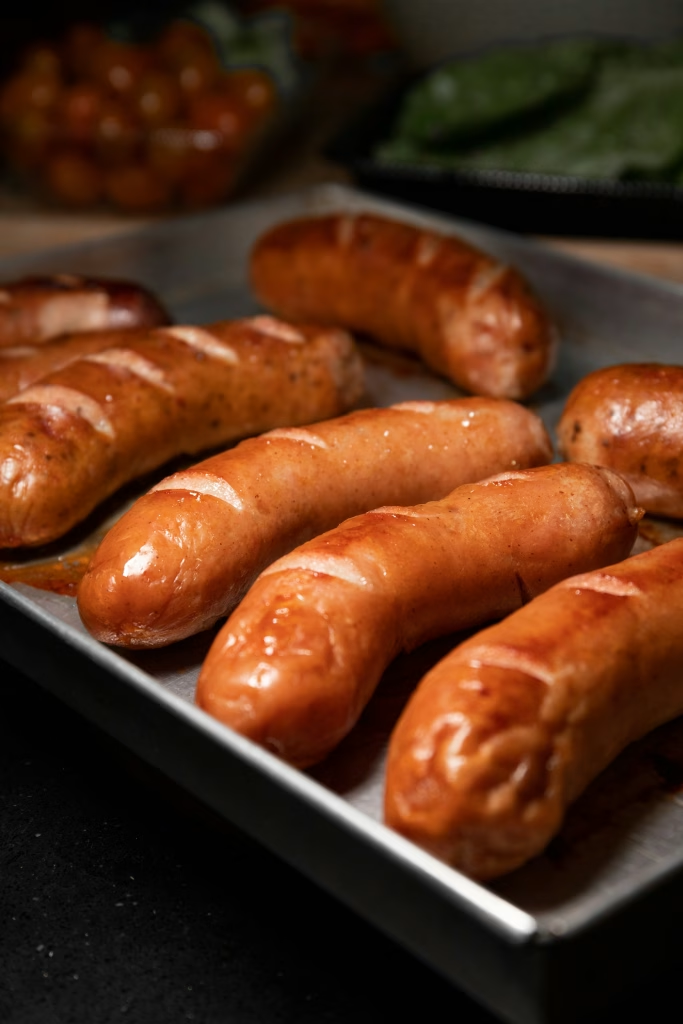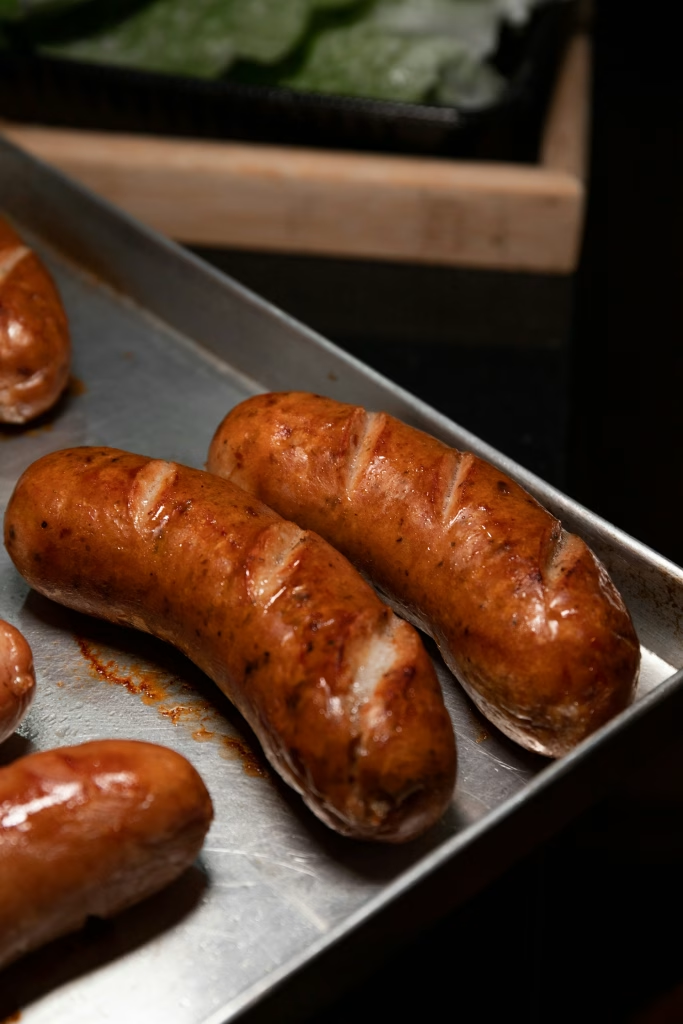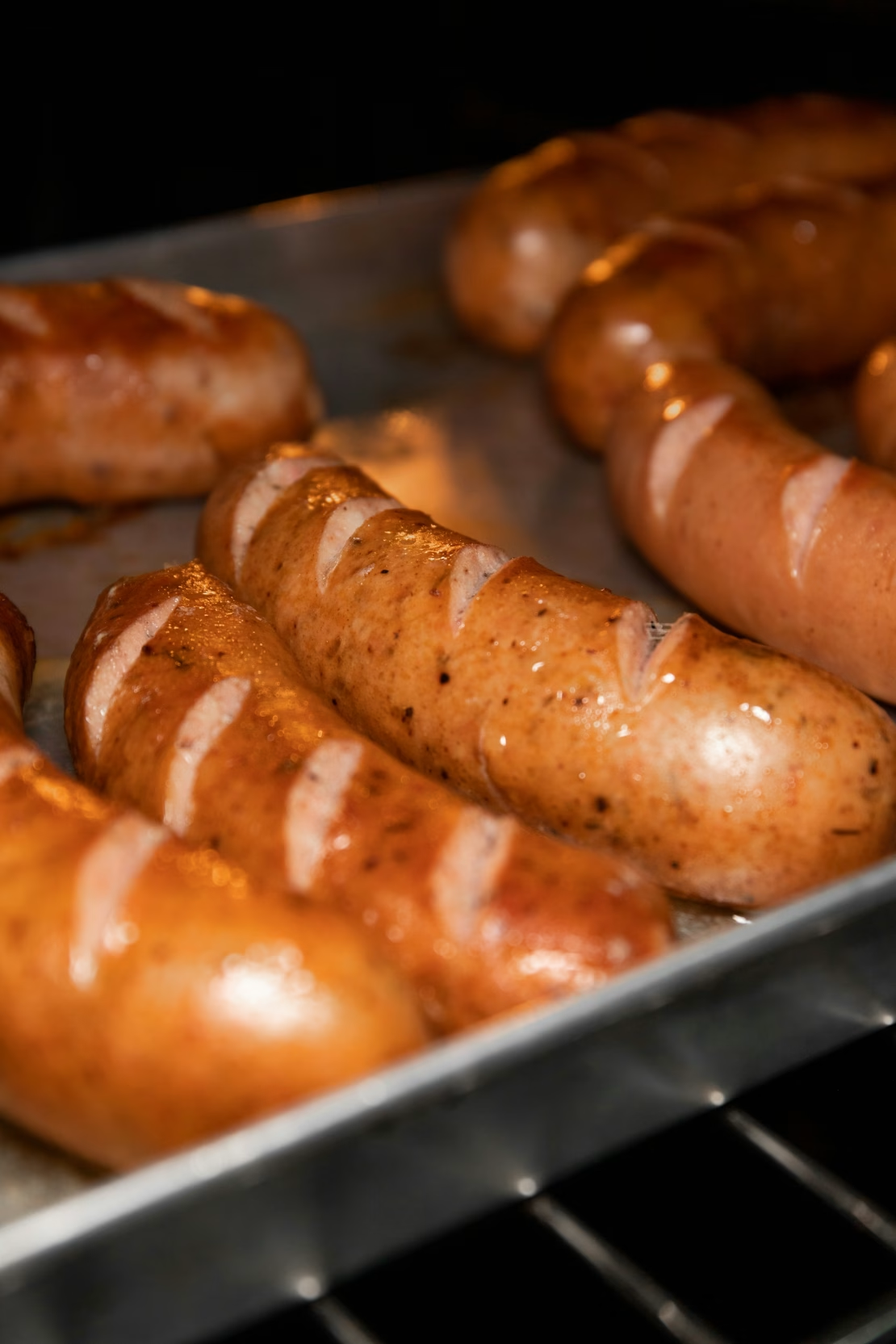When it comes to traditional German cuisine, few dishes are as iconic and beloved as German Bratwurst.
This juicy sausage, seasoned to perfection and often grilled or pan-fried, is not just a food, it’s a cultural symbol of Germany’s rich culinary heritage. Whether served in a crusty bun with mustard or on a plate alongside sauerkraut and potatoes, bratwurst brings the heart of Germany to your table.
In this comprehensive guide, you’ll discover a detailed German Bratwurst recipe, including ingredients, servings, step-by-step preparation, expert tips, healthier options, and a brief historical background.
Ingredients
Here’s what you’ll need to make an authentic German Bratwurst from scratch. This recipe uses natural pork casing and a spice blend typical of Thuringian and Franconian bratwurst styles.
For the Bratwurst Sausage Mixture:
- Pork shoulder – 2.2 lbs (1 kg), well-marbled
- Veal or beef (optional) – 0.5 lbs (250 g), for extra depth of flavor
- Back fat or pork fat – 0.4 lbs (200 g)
- Crushed ice – ½ cup (to keep mixture cold while grinding)
- Salt – 1 tbsp
- White pepper – 2 tsp
- Mace – ½ tsp
- Nutmeg – ½ tsp, freshly grated
- Garlic – 2 cloves, minced
- Marjoram (dried) – 1 tbsp
- Mustard powder – 1 tsp
- Sugar – ½ tsp
- Natural pork casings – about 2 meters, soaked in water and rinsed
Serves
This recipe yields approximately 12–15 bratwursts, depending on the size of your casing and how you portion the sausage mix. Perfect for a family gathering, Oktoberfest party, or a weekend cookout.
Step-by-Step Instructions
Step 1: Prepare the Meat
- Trim and cube the pork shoulder and fat.
- If using veal or beef, cut into cubes as well.
- Chill all meats and fat in the freezer for about 30 minutes to make grinding easier.
Step 2: Grind the Meat
- Using a coarse grinding plate (4.5 mm), grind all meat and fat through a meat grinder.
- Place the ground meat in a bowl over ice or refrigerate immediately to keep it cold.
Step 3: Mix the Spices
- In a small bowl, mix all the dry spices — salt, pepper, mace, nutmeg, mustard powder, sugar, and marjoram.
- Add minced garlic.
Step 4: Blend and Emulsify
- Add crushed ice and spices to the ground meat.
- Mix by hand or with a stand mixer fitted with a paddle attachment until sticky and emulsified.
- The mixture should be cohesive and slightly shiny. This takes about 5–7 minutes of mixing.
Step 5: Prepare the Casings
- Soak pork casings in warm water for at least 30 minutes.
- Rinse the inside by running water through them.
Step 6: Stuff the Sausages
- Load the sausage mixture into a sausage stuffer.
- Slide the casing onto the stuffing tube and slowly fill.
- Twist sausages into 6–7 inch lengths.
- Prick air bubbles with a pin to prevent bursting.
Step 7: Chill and Dry
- Let sausages rest uncovered in the fridge overnight to help them dry slightly and firm up.
Step 8: Cook or Grill
- Grill over medium heat until golden brown and cooked through (internal temp of 160°F / 71°C).
- Alternatively, simmer in beer or broth for 15 minutes and finish on a hot pan or grill for color.

Serving Suggestions
Bratwurst is incredibly versatile. Here are some classic and modern ways to serve German Bratwurst:
- Traditional Style: Serve in a crusty Brötchen (bun) with German mustard and sauerkraut.
- With Sauerkraut & Potatoes: A hearty plate of pan-fried bratwurst alongside tangy sauerkraut and buttered mashed or boiled potatoes.
- Beer-Braised Brats: Simmer bratwurst in German beer with onions, then grill and serve with the beer reduction.
- Currywurst Style: Slice grilled bratwurst, top with curry ketchup, and serve with fries.
- Breakfast Brat: Pair with eggs, toast, and grilled tomatoes for a German-American breakfast.
Tips for Perfect Bratwurst
- Keep Everything Cold: Cold meat grinds better and emulsifies properly. Use ice and chill utensils.
- Don’t Over-Stuff the Casings: Leave room for twisting and expansion during cooking.
- Use Quality Meat and Fat: Don’t skip the fat — it’s essential for juiciness and flavor.
- Rest the Sausages: Allow them to firm up overnight before cooking.
- Low and Slow Cooking: Avoid high heat to prevent bursting or drying out.
- Use Fresh Spices: For the best flavor, use fresh-ground nutmeg and high-quality marjoram.
Healthier Alternatives
While traditional bratwurst is rich and fatty, there are ways to enjoy it with a lighter twist:
- Lean Meat: Use a higher ratio of lean meat like turkey or chicken.
- Skip the Casings: Shape into patties or skinless sausages to reduce fat and sodium from natural casings.
- Steam or Bake Instead of Frying: Avoid deep frying or charring excessively.
- Low-Sodium Seasoning: Reduce salt and opt for herbs and garlic to enhance flavor.
- Serve with Salads: Pair with grilled vegetables, coleslaw, or leafy green salads for a lighter meal.
Creative Variations
Bratwurst can be adapted to suit a range of flavor profiles:
- Beer Cheese Brats: Add shredded cheddar and mustard into the sausage mix.
- Spicy Brats: Include chili flakes or jalapeños for a hot kick.
- Smoked Bratwurst: Cold-smoke sausages before grilling for a deep, smoky flavor.
- Apple and Sage Brats: Add grated apples and dried sage to the mix for a sweet-savory twist.
- Herbed Chicken Brats: Replace pork with chicken and use rosemary, thyme, and parsley.
Common Mistakes to Avoid
- Overworking the Meat: This can make sausages dense and rubbery.
- Too Much Fat or Too Little: Skipping fat makes bratwurst dry; too much makes it greasy.
- Improper Seasoning: Not enough salt or spice blend will result in bland sausages.
- Not Removing Air Pockets: Leads to uneven cooking or bursting.
- Skipping Rest Time: Cooking immediately after stuffing can ruin texture and shape.
History of German Bratwurst
The German Bratwurst has a fascinating culinary history that stretches back over 700 years. The term “bratwurst” derives from the Old High German words “brät,” meaning finely chopped meat, and “wurst,” meaning sausage. Contrary to popular belief, it doesn’t refer to “roasting” but to the method of making ground meat sausages.

Origins and Regional Differences
Bratwurst first appeared in Franconia (northern Bavaria) around the 14th century. Each German region soon developed its own variation, often reflecting local spice and meat preferences. The Thuringian bratwurst, for example, is known for its distinctive marjoram and leaner meat profile. Nuremberg bratwurst is shorter, thinner, and often served in multiples with sauerkraut or potato salad.
A Symbol of Tradition and Identity
Bratwurst isn’t just food in Germany—it’s part of the nation’s identity. Towns like Nuremberg and Coburg even hold bratwurst festivals. Recipes are often passed down through generations, and some butchers guard their family spice blends like state secrets. Bratwurst has also become a central part of German events like Oktoberfest, Christmas markets, and Sunday barbecues.
Bratwurst Goes Global
With German immigration during the 18th and 19th centuries, bratwurst found a new home in the United States. Cities like Milwaukee, St. Louis, and Cincinnati have strong bratwurst traditions. The sausage also became a staple at American sporting events and summer cookouts, helping it evolve into a beloved global dish.
FAQs About German Bratwurst
1. What is the difference between bratwurst and sausage?
Bratwurst is a type of German sausage made from pork, veal, or beef with distinct seasoning. Not all sausages are bratwursts — bratwurst has a specific spice profile and regional identity.
2. Can I freeze bratwurst?
Yes. Freeze raw or cooked bratwurst in airtight containers or vacuum-sealed bags. It will last up to 3 months in the freezer.
3. How do I know when bratwurst is fully cooked?
Use a meat thermometer. The internal temperature should reach 160°F (71°C) for pork or beef bratwurst.
4. Can I make bratwurst without a meat grinder?
Yes, though it’s easier with one. You can use pre-ground meat and mix in the spices thoroughly by hand.
5. What beer goes well with bratwurst?
A German-style lager, Weissbier, or Pilsner pairs wonderfully. For cooking, a malty beer like Märzen or Dunkel is ideal.
6. Are bratwursts spicy?
Traditional bratwursts are mildly seasoned with herbs like marjoram and spices like nutmeg — not spicy-hot unless customized.
7. How do you cook bratwurst without a grill?
Pan-fry, oven-bake, or simmer in beer and finish in a skillet for a nice sear.
8. What sides go best with bratwurst?
Classic sides include sauerkraut, potato salad, mashed potatoes, pretzels, and mustard.
9. Can I make bratwurst vegetarian?
Yes. Use plant-based protein, tofu, or tempeh and season with bratwurst spices. Stuff into vegan casings or serve as patties.
10. Is bratwurst gluten-free?
Homemade bratwurst is usually gluten-free, but always check store-bought versions for fillers or additives containing gluten.
The German Bratwurst is more than a sausage — it’s a centuries-old culinary tradition, a cultural icon, and a flavor-packed favorite that unites generations around the grill. Whether you’re looking to try an authentic homemade recipe, explore healthier twists, or learn the rich history behind this beloved dish, bratwurst has something for everyone.
With just a few ingredients, some care in preparation, and a little knowledge of German tradition, you can bring a slice of Germany to your own kitchen. Fire up the grill, serve it with mustard and kraut, and savor the unforgettable taste of an authentic German bratwurst.


